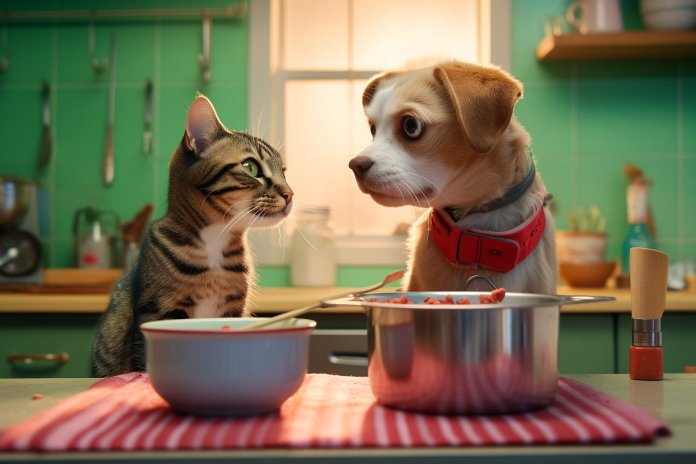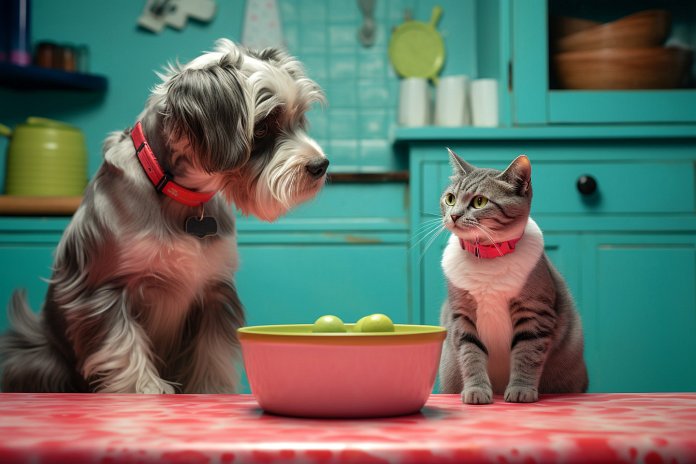
It appears that some dogs find cat food very tempting, but can dogs actually taste or enjoy cat food? There is a misconception that dogs have a greater or lesser ability to taste than they actually do. While dogs can taste things, their taste capacity is not the same as humans.
When it comes to cat food, the high-protein formula is likely to attract dogs to try it, but is it safe for them? Read on to learn more about dogs and cat food.
Signs of Dogs Tasting Cat Food
Dogs have a strong sense of smell, so it makes sense that the scent of cat food would attract them. But why do they keep coming back for more? The taste of cat food is good enough that dogs will take any opportunity to eat it, so it should always be kept out of reach or in a secure container.
The fact that dogs eat cat food is the biggest sign that they can taste it. While dogs don’t always eat for pleasure like humans do, most pet dogs have access to plenty of food, so they don’t need to eat cat food. If they didn’t enjoy it, they would leave it alone.
When dogs notice cat food, you may see their noses twitch and them sniff the air. Dogs have a sensitive sense of smell, which helps them find the tasty cat food. They may also wag their tails when they see or smell cat food, indicating their happiness.
Body Language
Here are some signs that your dog may be eating cat food:
– Alert
– Chewing
– Jumping up
– Wagging tail
Other signs of dogs tasting cat food include tearing into a bag of cat food, excitedly eating cat food, sniffing in the direction of the cat food, and wagging its tail when it sees, smells, or eats cat food.
History of Dogs Tasting Cat Food
Since commercial cat food became available in the 1800s, dogs have likely been munching on it. Whether it’s wet or dry, dogs can’t seem to resist it. Scientists believe that the higher protein content in cat food makes it desirable for dogs, but the exact reason why dogs love it is unknown.
Another reason dogs may love cat food is that it is sometimes used as treats for dogs during training. This is great for training purposes, but not so great for keeping dogs away from cat food as adults.
Cat food is higher in protein than most dog foods, making it delicious for dogs. However, it’s not a good idea to let your dog eat cat food because it can cause upset stomach, vomiting, and diarrhea. Consuming large amounts of cat food can also lead to pancreatitis, kidney, and liver damage.
Science Behind Dogs Being Able to Taste Cat Food
Humans have around 9,000 taste buds, while dogs only have about 1,700. This means that dogs don’t have the same taste ability as humans. However, dogs have taste classifications like humans, including sweet, sour, salty, and bitter. Dogs also have special taste buds for water, which humans don’t have. These taste buds are found on the tip of the tongue and help prevent dehydration in animals.
Dogs’ taste buds enjoy things they would have eaten in the wild, such as meat, fruits, and vegetables. Since cat food has more protein than dog food, dogs are fond of it. However, eating too much protein can make dogs feel sick.
Training Dogs to Not Eat Cat Food
While you don’t need to train your dog to taste cat food, you can train them to leave the cat food alone. Since eating cat food can cause health issues, it’s important to either keep the cat food away from your dog or teach them to avoid it.
If you notice your dog eating cat food, remove the food and consider feeding your cat in a different location to prevent your dog from accessing it. Store bags of cat food in containers or rooms that your dog can’t get into to avoid theft.
Minimizing the chance of your dog consuming cat food is the best way to keep them safe. Some trainers recommend using cat kibble or treats for dogs during training because it motivates them. However, if you have a cat in your home, it’s best to avoid this method as it may cause the dog to continue eating the cat’s food.
“Cat food may be a tasty temptation for dogs, but it’s important to keep them safe from potential health risks.”

Tips & Things to Know
1️⃣ Keep cat food out of reach: Dogs are often tempted by the scent and taste of cat food, so it’s important to keep it in a secure place that your dog can’t access. This will prevent them from eating it and potentially getting sick.
2️⃣ Watch for signs of dogs tasting cat food: If you notice your dog eating cat food, wagging its tail when it sees or smells it, or sniffing in the direction of the cat food, these are signs that they are enjoying the taste and may continue to seek it out.
3️⃣ Minimize your dog’s access to cat food: Try to train your dog to leave cat food alone or feed your cat in a separate area where your dog cannot reach. Storing cat food in containers or rooms that your dog cannot access can also help prevent them from stealing it.
Frequently Asked Questions, Answered ✅
1. Can dogs taste and enjoy cat food?
– Yes, dogs can taste cat food and they often enjoy it due to its high-protein formula.
2. What are the signs that dogs have tasted cat food?
– Dogs may show signs such as alertness, chewing, jumping up, wagging their tail, tearing into a bag of cat food, excitedly eating cat food, sniffing in the direction of cat food, and wagging their tail when they see, smell, or eat cat food.
3. Why do dogs love cat food?
– Dogs are attracted to cat food due to its higher protein content. It is also sometimes used as treats for dogs during training.
4. Is it safe for dogs to eat cat food?
– While a small amount of cat food may not be harmful, it is not recommended for dogs to regularly consume it as it can cause upset stomach, vomiting, diarrhea, and even pancreatitis, kidney, and liver damage.
5. How can I prevent my dog from eating cat food?
– You can train your dog to avoid cat food or keep it in a location inaccessible to your dog. Storing cat food in containers or rooms that your dog cannot access is also recommended.